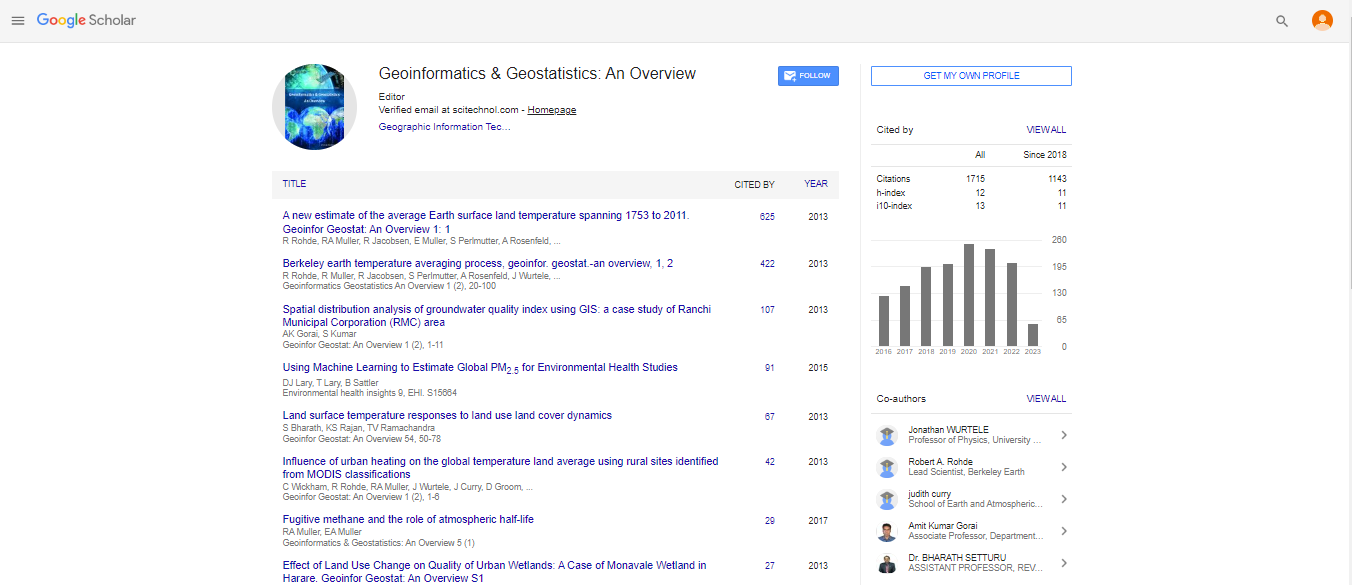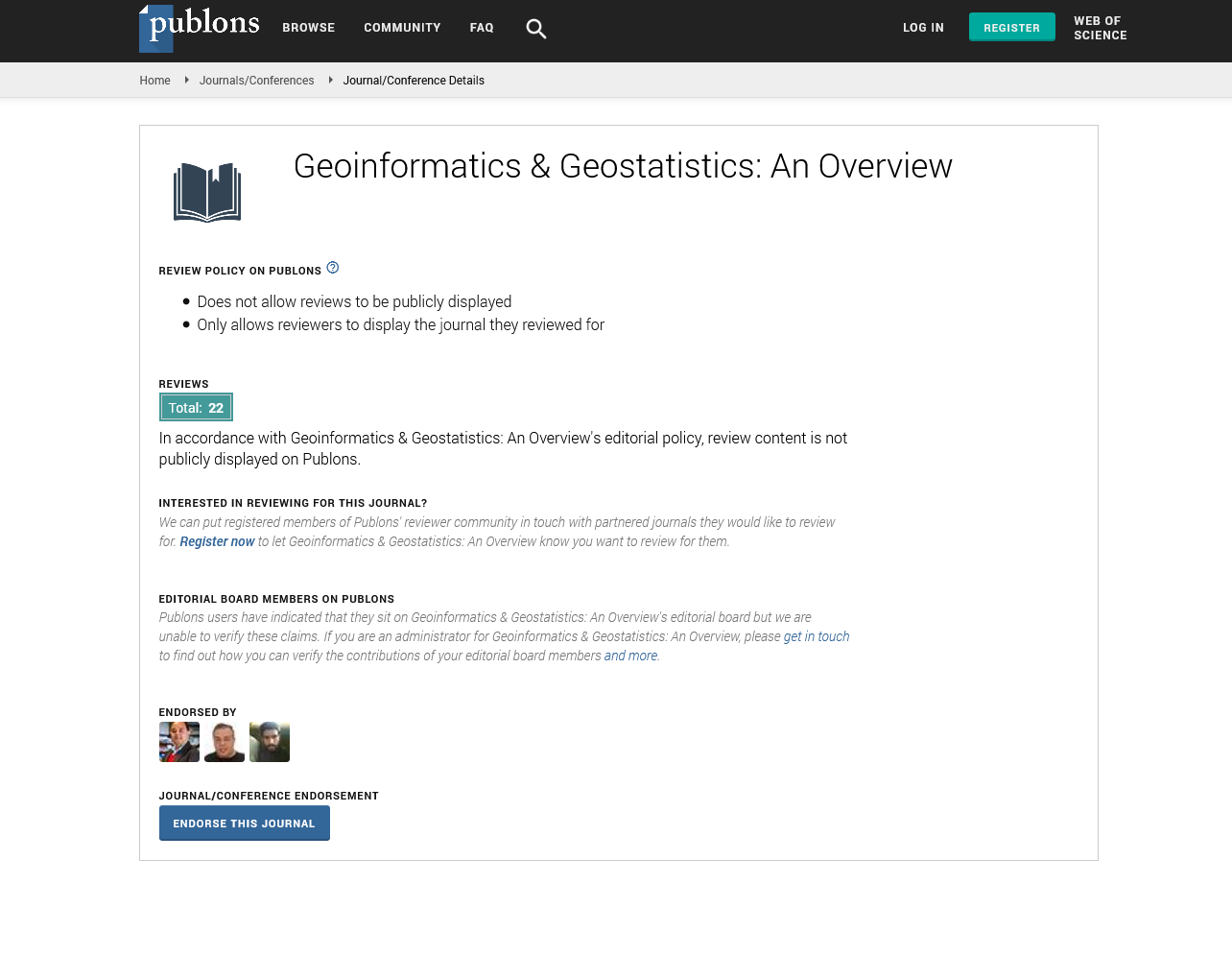Research Article, Geoinfor Geostat An Overview Vol: 12 Issue: 5
Prediction of Reaeration and Deoxygenation Rate Constant in Selbe River, Mongolia: Dissolved Oxygen and BOD Assimilative Capacity of the River
Ariuntuya Tserendorj1*, Bodigerel Lkhagvasuren1, Usukhbayar Puntsagsuren1, Gerelt-Od Dashdondog2
1Department of Raw Material and Environmental Engineering, German-Mongolian Institute for Resources and Technology, Ulaanbaatar, Mongolia
2Division of Water Resources and Water Utilization, Institute of Geography and Geoecology, Ulaanbaatar, Mongolia
*Corresponding Author: Ariuntuya Tserendorj,
Department of Raw Material and Environmental Engineering, German-Mongolian Institute for Resources and Technology, Ulaanbaatar, Mongolia
E-mail: ariuntuya@gmit.edu.mn
Received date: 30 September, 2024, Manuscript No. GIGS-24-149241;
Editor Assigned date: 02 October, 2024, PreQC No. GIGS-24-149241 (PQ);
Reviewed date: 16 October, 2024, QC No. GIGS-24-149241;
Revised date: 23 October, 2024, Manuscript No. GIGS-24-149241 (R);
Published date: 30 October, 2024, DOI: 10.4172/2327-4581.1000412.
Citation: Tserendorj A, Lkhagvasuren B, Puntsagsuren U, Od Dashdondog G (2024) Prediction of Reaeration and Deoxygenation Rate Constant in Selbe River, Mongolia: Dissolved Oxygen and BOD Assimilative Capacity of the River. Geoinfor Geostat An Overview.12:5.
Abstract
In rivers, the processes of deoxygenation and reaeration play major roles in self-purification, particularly influenced by temperature changes. This study is the first to consider Mongolia's river's Dissolved Oxygen (DO) and Biochemical Oxygen Demand (BOD) assimilative capacity. The objective of the study was to determine the deoxygenation rate (k1) and the reaeration rate (k2) constants of the Selbe River, in Ulaanbaatar, Mongolia. The mean k1 was calculated using two models, namely the Thomas slope and firstorder function methods. The results showed that the first-order function model was more suitable for describing k1, which is 0.116 ± 0.012 and 0.266 ± 0.0281 respectively in 10 and e of logarithm base because the sampling standard deviation of the model we used is more reliable than the Thomas method. The mean k2 was estimated by 8 models out of 22 different available models. Jha’s model was more reasonable because it had the lowest sampling standard deviation compared with other models. Accordingly, the mean k2 in the Selbe River was found to be 3.41 ± 0.67 at 4.97 mean temperature of Celsius. As a result of using k1 and k2, there is 0.7 mg/L of mean critical oxygen deficit, 0.3 d of critical time and4.7 km of the longest distance using the purification model for steady-state at 20ºC because non-point pollution sources occurred in most sampling points. Additionally, considerations should include the trend towards stronger rainfall events, changes in land use density with an increasing number of pit latrines, variations in soil types and the presence of private wells, all of which are potential drivers of changes in water hygiene.
Keywords: Biochemical Oxygen Demand (BOD); Dissolved oxygen; Deoxygenation rate; Reaeration rate; Critical time; Deficit oxygen.
The northern region of Mongolia receives 350 mm of rainfall per year, while the southern part of the Gobi Desert only receives 80 mm [1,2]. As a result, Mongolia is categorized as a country with low rainfall. Despite this, the national average for per capita water availability remains relatively high. However, specific areas face water security challenges due to variations in rainfall and population distribution across the country. Particularly vulnerable are the city of Ulaanbaatar, which is home to half of the population and the water-dependent mining companies in the Gobi region. In Mongolia, groundwater is the main source of drinking and industrial water due to seasonal fluctuations and the freezing of river flow during winter. Additionally, the country’s valuable and fragile ecological system requires the careful management of natural water resources on a large scale. The effects of climate change are already evident in Mongolia, with the annual average temperature having increased by 2°C [3]. Therefore, it is necessary to prepare for upcoming challenges.
According to the 2015 study, the assessment of subterranean water resources in Mongolia is insufficient for the purpose of establishing and assessing trends. Nevertheless, by utilizing satellite measurements of variations in surface water accumulation, it becomes apparent that surface water accumulation has consistently declined in the central region of Mongolia, particularly in Ulaanbaatar [2]. Moreover, there has been a notable surge in precipitation in recent years, reaching levels that lead to flooding, which could potentially be attributable to climate change.
Surface water plays a major role in providing a vital habitat for numerous bird species in the challenging environmental conditions of Mongolia, which can be characterized as both dry and cold. Lakes and wetlands, in particular, serve as essential breeding grounds for migratory birds. As a result, Mongolia has implemented a longstanding practice of maintaining its natural flow requirements at 90%-95% of the average flow. This approach ensures the long-term sustainability of ecosystems and supports the livelihoods of local communities that rely on river basins, lakes and wetlands. Therefore, the allocation of water necessary to maintain ecosystem stability and support human well- being, including natural runoff, plays a significant role in the integrated management of water resources in Mongolia [2].
Ulaanbaatar, Mongolia’s capital, is intersected by the Selbe River, a major urban waterway that flows through the city’s central region from north to south before curving westward. After this westward turn, the river is referred to as the Dund River. The Selbe and Dund Rivers are a significant tributary of the mountainous Tuul River Basin, flowing along the southern periphery of Ulaanbaatar. Tuul River basin is part of the Arctic Ocean continental basin.
The mass balance of Dissolved Oxygen (DO) in rivers and streams involves a dynamic interaction between deoxygenation and reaeration rate constants, which are critical for predicting a water body’s purification capacity. The classic Streeter-Phelps model, along with a modified version, is used to describe the critical oxygen deficiency and the critical time or distance in the river [4]. By analyzing the DO concentration, deoxygenation rate coefficient and reaeration rate constant, we can predict the natural purification process of a stream and assess its pollution levels using the modified Streeter Phelps equation. This modified model has demonstrated that global warming significantly reduces dissolved oxygen levels in rivers, thereby negatively impacting their Biochemical Oxygen Demand (BOD) assimilative capacity [4]. The classic Streeter-Phelps model is based on the assumption that only two processes are involved: The deoxygenation rate from BOD and the reaeration rate by oxygen transfer at the surface water [4]. Developed in 1925, the Streeter-Phelps model focuses on critical DO levels at critical times, a period when climate change was not yet a concern. Steven and his co-researchers refined and simplified this model to determine the critical DO concentration under conditions of zero initial oxygen deficit and no BOD losses due to settling [4]. Concurrently, studies on river water quality have predicted DO depletion in response to changes in streamflow, temperature and land use globally [5-9]. To determine changes and trends in average water temperature, rivers and lakes with long-term observation records were selected across three continental basins, the Arctic Ocean, Pacific Ocean and Central Asian Internal, in Mongolia. By comparing the average maximum annual temperatures from 1961-1990 with the trends over the entire observation period and the averages from 1991- 2008, a period when climate change intensified, it was found that the annual maximum temperature of rivers in Mongolia increased by 0.9ºC-2.0ºC [3]. In other research focused on arid and semi-arid regions, it has been shown that even minor changes due to natural or anthropogenic factors can significantly impact the ecosystem balance [10]. For instance, this trend is certainly influenced by climate change in some river basins in Mongolia. Over the past 30 years, the average annual air temperature in the Khovd River basin has increased by 0.78ºC [11].
There are several methods for estimating the deoxygenation rate constant, including the rate of BOD oxidation. This standard model is based on a first-order kinetic function (Equation 1), which involves time (t), Ultimate Biochemical Oxygen Demand (UBOD) and the deoxygenation rate constant (k1). Other methods include non-linear regression, the logarithmic method of Thomas (Equation 2) the two-point method, the rapid ratio method and the Fujimoto methods [12-14]. These various approaches offer different ways to accurately determine the deoxygenation rate constant, which is essential for understanding oxygen dynamics in water bodies.

Reoxygenation is the physical absorption of oxygen from the atmosphere by water bodies. The reaeration constant rate is estimated by the hydraulic data of the rivers and streams. The reaeration rate is the amount at which oxygen is transferred from the air to the water. Fast-moving, shallow, turbulent streams are more effectively reaerated. When the rate of reaeration equals the rate of deoxygenation, the stream has the lowest dissolved oxygen level [15]. Oxygen transfer occurs in two layers: The gas layer and the liquid layer. Due to the low solubility of oxygen in water, oxygen movement is governed by the rate of transfer across the liquid column at the air-water interface. The flux of oxygen, which is the rate of change of DO in a water segment of volume per unit area, through this controlling liquid layer, can be expressed as follows [16]. For relatively small rivers and streams, the reaeration rate coefficient is affected by the river depth (H), velocity (U) and slope (S). Therefore, the functional relationships between the reaeration rate coefficient (k2) and the variables H, U and S can be written as (Equation 3).

Determining the reaeration rate is major for simulating an optimal model for the target area. Various models have been developed for estimating the reaeration rate coefficient (k2), which have been widely used in open sources. The primary variables to describe the reaeration rate are the velocity, depth and slope of the river or stream. These models can be categorized into two groups: One consisting of 9 models that use velocity and depth and another consisting of 13 models that use velocity, depth and slope [17]. Jha and his co-researchers investigated eleven equations using the least squares algorithm to predict the reaeration rate constant (k2) [18]. They aimed to minimize error estimation and improve the correlation between observed and computed k2 values. Melching and his co-researchers developed a model for the reaeration rate constant using data from 166 streams in 23 states, collected by the U.S. geological survey [19]. These estimation models were determined based on whether the flow rate in the stream was higher or lower than 0.556 m³/s. The parameters affecting k2 were identified and categorized into four groups, reflecting their relationships [4]. There is evidence indicating that the Selbe River has exceeded permissible levels of Pb, Zn and high nutrient concentrations [20]. Pollution upstream of the river may originate from underground flow and run off from per areas, where households use unsealed pit latrines and dispose of solid waste openly on the streets, including ash. In 2022, there were over 144 992 pit latrines in the per area of Ulaanbaatar [21]. Consequently, we aimed to determine the deoxygenation rate coefficient and reaeration rate constant using kinetic and Thomas models, respectively. Additionally, we plan to employ various models to verify pollution levels in the Selbe and Dund rivers, applying both the classic and modified Streeter- Phelps equations. These parameters are major for river analysis as they offer vital insights into water body health and quality. By identifying pollution sources, managing water resources and ensuring compliance with regulations and standards, we can better understand dissolved oxygen dynamics and safeguard the environmental integrity of these rivers. Indeed, water resources management necessitates a comprehensive understanding of the rates at which oxygen is replenished and consumed within rivers. This knowledge is critical for ensuring the sustainable conservation of water bodies. By understanding the dynamics of oxygen levels, authorities can implement effective measures to maintain ecological balance, support aquatic life and safeguard the overall health of freshwater ecosystems.
Materials and Methods
This study aims to investigate the Selbe River, located in the densely populated metropolitan areas of Ulaanbaatar, where approximately 46% of Mongolia’s population resides. Since 1990, the city’s population has grown significantly, leading to increased development in formerly less populated, higher-altitude watersheds. Unfortunately, adequate flood safety systems have not been established, exposing the city to significant flood risks. This vulnerability was evidenced by the July, 2023 floods that affected the central area of the city, compounded by the Selbe and Dund Rivers. Despite its relatively pristine condition, being colder and wellaerated, the river faces potential pollution challenges, including soil contamination from open pit latrines.
The Selbe River originates from the confluence of the Bayan River and the Khadgait River. The Bayan River, which rises between the Bayan Ikh (elevation 2,033.3 meters) and the Tsohiot mountains (elevation 1,706 meters) within the Baga Khentii range, is one of its primary sources. After its formation, the Selbe River meanders through a forested meadow valley from north to south until it reaches the centre of Ulaanbaatar. Approximately two kilometres further on, the river shifts direction from east to west, where it is known as the Dund River, before finally discharging into the Tuul River. Mongolia features 29 river basins, one of which is the Tuul River basin (Figure 1).

Figure 1: Study land area Selbe River Catcment area with sampling points.
The Selbe River has two major tributaries, the Khandgait River and the Belkh River along the upstream and downstream, respectively. Additionally, heavy rains contribute to mountain runoff, further augmenting the flow of the Selbe River. The river spans a length of 35 km, with a catchment area covering 308 km². The average altitude of the basin stands at 1380 m above sea level, with a riverbed slope of 0.98%. Classified as a 3rd order stream, the Selbe River features an average floodplain width ranging from 100 m to 150 m, expanding to 400 m to 500 m in certain sections the height of the side slope measures 4-5 m. The riverbed of the Selbe River has undergone gradual alteration, experiencing recession and the formation of small islands in certain areas. The width of the riverbed ranges from 20 m to 25 m, with an average water depth varying between 0.1 m and 0.5 m. The height of the riverbank measures between 0.4 m and 0.6 m. Over extended periods, the average flow rate of the river ranges from 0.51 m³/s to 0.79 m³/s, while during higher flow events, it can reach between 5.96 m³/s and 9.84 m³/s [22]. In recent years, the Selbe River has undergone significant changes, losing its original state and appearance largely due to unplanned urbanization. The upstream sections are now surrounded by ger areas where each household uses pit latrines, contributing to the contamination that eventually finds its way into the river. Specifically, points such as Sharga morit, Jigjid, Dambadarjaa, (next upstream sampling point) and Zuun-Ail (next upstream point) are notable sources of pollution. As the river progresses, it flows amidst apartment and commercial areas in the centre of the city, passing by locations like Chinggis Hotel (middle sampling point), Ikh Nayad (before downstream) and Altai Town (last downstream) (Figure 1). Unplanned urbanization, particularly in the upstream ger areas with the widespread use of pit latrines, has led to significant contamination of the river. As the river flows through densely populated apartment and commercial areas in the city centre, such as Chinggis Hotel, Ikh Nayad and Altai town, the combined effects of pollution and altered river dynamics have exacerbated the river’s degradation and heightened flood risks.
The study area focuses on two distinct sections of the Selbe River the upstream region, surrounded by per areas and the downstream region, densely built with structures. Notably, the Dund River’s watershed area can be considered separate from the Selbe River, as it sharply turns from a North-to-West direction. The floodplain downstream is constrained by building construction, contributing to a heightened risk of flooding. The combination of unplanned urbanization upstream and dense construction downstream has significant implications for both the river’s ecological health and flood management.
Due to the geological formation and hydrogeological conditions, previous researchers have classified the stratigraphy of the Selbe River area into four levels, namely, modern Quaternary alluvial-prolusion (al-Ñ?Q2- 3), sedimentary aquifers, modern Quaternary DeluvianProluvian (dl Q2-3) sedimentary period, Neogene aquifer (N2-3) and fracture zone of Early Tormulian bedrock containing water-dappled holes (Ð Z2-3) [15]. Understanding these stratigraphic levels is major for analyzing water quality, managing resources and predicting environmental impacts, providing valuable insights into the area’s geological and hydrogeological framework.
Among the hydrogeological stratigraphy, the phase containing groundwater within the alluvial-proluvial sediments (al-Ñ?Q2-3) is the most widespread. Other phases, layers and zones are distributed in the central and northern peripheries of Ulaanbaatar city. Beneath the friable sediments, there is a broad distribution of fracture zones in the early mollusc bedrock, characterized by water-dappled holes. In the central and northern parts of the city, water-bearing periods can be found in the alluvial-colluvial sediments, primarily located along the fault lines around the Selbe River. At the upstream points of Dambadarjaa and Zuun Ail, the underground water near the Selbe River is contained within Quaternary friable sediments. Many families live nearby and rely on private wells, which has led to a reduction in groundwater levels and increased pollution along the river [23]. Another important issue in Mongolia is that the acceleration of the warming trend is occurring at twice the rate predicted by global warming models. Since the 1940s, the mean air temperature in Mongolia has increased by approximately 2.1ºC [24].
Data collection and analysis
The data from the river measurements (Table 1 and Annex 1). The sampling points were selected based on safety considerations for measurements, as some areas on the river floodplain are highly concreted. Therefore, the distance between sampling points does not follow a uniform length. However, this variation in distance between sampling points does not significantly disturb the analysis. The sampling points are listed from an upstream point to a downstream point, with “Sharga Morit” being the upstream point on the Selbe River and “Altai Town” being the downstream point on the Dund River (Table 1). The average river flow measures 0.32 m3/s. A consistent decline in flow has been observed when compared to the previous data range of 0.51 m3/s - 0.79 m3/s, as mentioned in the study area (Table 1). Our primary objective is to guarantee the long-term sustainability of ecosystems and bolster the livelihoods of local communities reliant on river basins.
Table 1: Hydrological data of the river.
Water sampling was conducted in mid-November, 2021 and April, 2022 and May, 2022 and late April, 2023. These periods typically feature the river as a shallow, high energy stream due to melting runoff from the mountains during the transition from winter to spring. Mongolia has a temperate climate, with winter lasting from late November to mid-March, approximately six months. A samples took between 1-3 hours. To avoid traffic jams, sampling was conducted from 10 am to 4 pm. The Biochemical Oxygen Demand of five days (BOD5) and the Ultimate Biochemical Oxygen Demand (UBOD) were tested using the BD600 Lovibond respirometric device. This device provided values for up to 28 days, allowing for the determination of the deoxygenation rate using first-order kinetic reaction. The BOD system measures the formation of carbon dioxide, which is captured by potassium hydroxide in the top of the sealed bottle. The removal of CO2 leads to a pressure drop that is directly proportional to the oxygen consumed by organisms. This measurement is conducted in a closed vessel with constant temperature and agitation. The system saves time, reduces the potential for errors and facilitates easy data testing. Simultaneously, Chemical Oxygen Demand (COD) was measured using the closed reflux method with the HACH DR/870 colorimeter. This device features automatic wavelength selection, advanced reagent blank correction and calibration curve adjustment. Results are displayed as concentration, total of 14 samples were collected from seven points along the Selbe River (Table 1). Three samples each were taken from the middle sampling point and the downstream-1, one sample each from the first two upstream-1 and two samples each from the third upstream-1, the upstream-2 and the downstream-2. The middle sampling points, downstream-1 and downstream-2 are surrounded by high-density urban apartment areas, while the three upstream-1 points and upstream-2 are surrounded by ger subdistricts (Table 1 and Figure 1). All samples were transported to the laboratory within 3 hours. We followed the MNS ISO 5667- 6:20011 standards, utilizing grab sampling techniques. Sampling plastic bottles were fully immersed in the water three times and rinsed with the sample. The initial samples were collected on 16 November, 2021 from the middle sampling point and downstream 1 sampling point on the river. The elevation and distance between sampling points were plotted using satellite imaging systems, including Google Earth Pro and ArcGIS. Using these data, the slope of the river area was estimated at each sampling point (Table 1). The total distance between the first and last sampling points is approximately 23 km (Figure 1). The transportation of absorbance and percentage transmittance. Digestion was carried out using the Block DRB 200 Digital Reactor in the laboratory, with the procedure completed in two hours. This testing method is safe, reduces errors due to human activities and facilitates easy data production. DO and river velocity were measured using the YSI ProODO, which follows Environmental Protection Agency (EPA) approved methodology and the March-McBirney Flo-Mate 2000 and SEBA Hydrometrie FlowSens devices for electromagnetic onsite measurement. The deoxygenation rate of the Selbe River is determined using two different models: The first-order function method (Equation 1) and the Thomas slope method (Equation 2). The reaeration rate constant is calculated from hydrological data collected at sampling points along the Selbe River. Out of the 22 models considered, 8 models were selected based on stream classification and interpreted accordingly.
Results and Discussion
First, before determining the deoxygenation rate k1, we have focused on water quality data as shown in Table 2. The determination of the deoxygenation rate constant is analyzed based on oxygen demand, specifically total Biochemical Oxygen Demand (BOD). Total BOD comprises two main components: Carbonaceous Biochemical Oxygen Demand (CBOD), which includes Ultimate BOD (UBOD) and oxidizable organic carbon and Nitrogenous Biochemical Oxygen Demand (NBOD), which consists of ammonia and readily oxidizable nitrogen. These components collectively contribute to understanding the oxygen depletion dynamics in the water body under study. The BOD5 value and UBOD are derived from detailed BOD data. The BOD test spans several days to measure the dissolved oxygen consumption by bacteria, algae, fungi, protozoa and archaea present in the water sample. Between 2013 and 2019, BOD5 and DO were measured at four monitoring stations along the Selbe River: Selbe-Ulaanbaatar, Selbe-Dambadarjaa, Selbe Dund River andSelbe-Sanzai. The average BOD5 ranged from 1.1 mg/L to 33.53 mg/L, with a maximum of 98.8 mg/L recorded at the Selbe River. The average DO ranged from 6.44 mg/L to 11.95 mg/L, with a maximum of 12.20 mg/L [25]. Our results show the mean ultimate BOD of the Selbe River is 52.7 mg/L, BOD5 is 31.38 mg/L, DO is 9.79 mg/L at a mean temperature of 4.97°C and COD is 603.6 mg/L (Table 2), indicating significant pollution from nonbiodegradable organic compounds. Comparing the BOD5 and DO data from 2013 and 2019, the values are relatively similar, indicating the reliability of our results in Table 2. DO concentration was inversely related to BOD5 along the sampling points, while COD was directly proportional to DO. This suggests that the relationship between COD and DO might not be straightforward because COD includes both organic and inorganic substances. Additionally, the downstream-2 sampling point has been near the construction material marketplace, where activity has been ongoing since 1991 (Figure 2). The measurement of BOD5 at each time unit and UBOD is evaluated using two different models the Thomas slope model and the first-order function model (Table 2). However, due to the lack of organic matter in water samples at the first two upstream-1 sampling points, BOD oxidation was not accounted for in these locations. Therefore, data from five sampling points from the third upstream-1 to downstream-2 over two years were calculated to determine the deoxygenation rate k1 for model simulation using Equation 1 and Equation 2 The analysis of the BOD test has indicated the absence of readily oxidizable organic nitrogen and ammonia, collectively referred to as “reduced nitrogen.” BOD levels remain sustained from 11 days to 28 days. When comparing data of BOD5 and COD to Mongolian National Standards of aquatic environmental water quality, it exceeded the permissible level from the middle to downstream points [26].
Table 2: The water quality measurement in different areas
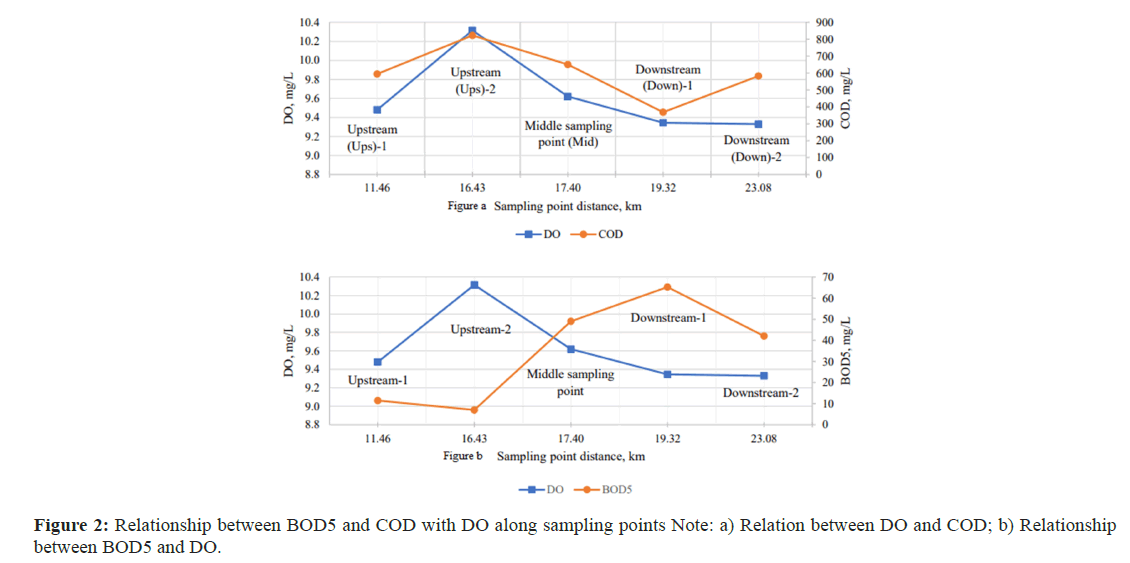
Figure 2: Relationship between BOD5 and COD with DO along sampling points Note: a) Relation between DO and COD; b) Relationship between BOD5 and DO.
At the upstream-1 sampling point, DO concentrations were supersaturated in 2022, meaning the actual DO concentration was higher than the saturated DO. However, in 2023, the actual DO was less than the saturated DO (DOsat) estimated by the American Public Health Association [27]. The average DO over the two years was lower than DOsat (Table 3). Saturation values of DO provide useful insights into how saturation is affected by temperature, salinity and elevation. The elevation of the study area is approximately 1300 m above sea level and the water is relatively fresh with a low temperature during the sampling period. Dissolved oxygen levels were above 9.33 mg/L at all water sampling points, suggesting that the river has a good oxygenation status, which supports its capacity to assimilate BOD. However, the critical distance for BOD assimilation depends on multiple factors, including flow rate, temperature and microbial activity. We plan to continue data collection in our study area to make further refinements.
Table 3: The deoxygenation rate constant (BOD oxidation), 1/d.
Table 3 reports the estimated deoxygenation rates at five of the seven sampling points- Upstream-1, Upstream-2, Middle Point, Downstream-1, Downstream-2. As previously mentioned, the BOD measurements at the first two upstream sampling points were unsuccessful, possibly due to the presence of disturbance substances, very low concentrations, or only one sample being available at each point. The sample standard deviation using the first-order function method was 0.0599 in the natural logarithmic base and 0.0260 in the base-10 logarithmic scale. In contrast, the Thomas method yielded standard deviations of 0.1737 in the natural logarithmic base and 0.1453 in the base-10 logarithmic scale.
To confirm the reliability of the Thomas slope method for determining the value of k1, the correlation coefficient R2 should be close to 1, as the method (Equation 2) should produce a linear relationship. However, the estimation results showed very low R2 values of 0.16 and 0.15 at the middle sampling points and downstream-1, respectively (Table 2) [28]. Therefore, the k1 value for the Selbe River was derived using the first-order function method, resulting in 0.2465 in the natural logarithmic base, which indicates the river’s capacity to assimilate organic waste.
Secondly, to determine the reaeration rate k2, hydrological measurements including depth, slope and velocity are modelled using Equation 3. Depth at each meter across the river width was manually measured to estimate the river’s flow rate (Table 1 and Annex 1). The mean reaeration rate constant of the Selbe River is initially calculated using 22 previously discovered k2 models [17]. The focus is on selecting the optimal model based on statistical parameters, particularly the standard error. For the reaeration constant rate, we used eight models out of 22 suitable for small streams and rivers as described by Haider et al., [17]. The selected models and authors’s corresponding equations are Bennett and Rathbun (BR) Equation (4); Grant (GR) Equation (5); Isaacs and Gaudy (IG) Equation (6); Jha et al., (JH) Equation (7); O’ Connor and Dobbins (OD) Equation(8); Owens et al., (OW) Equation(9); Smoot (SM) Equation(10); and Thyssen et al., (TH) Equation(11) [10,18,19]. In the case of statistical analysis, the mean reaeration rate k2 in the Selbe River ranged from 3.9 using the Jha et al., (JH) model to 65.0 using the Thyssen et al., (TH) model [20-23]. In Figure 3, both Jha’s (JH) and Smoot’s (SM) models exhibit short whiskers on either side of the box, indicating more concentration and less variability, despite the whisker extending slightly longer at the bottom, suggesting a slight skew in the distribution. In contrast, the whiskers in other models are much longer, indicating greater variability. Due to the lower variability and higher concentration of values, we selected the Jha et al., (JH) and Smoot (SM) models (Equation7 and Equation10) for further study.
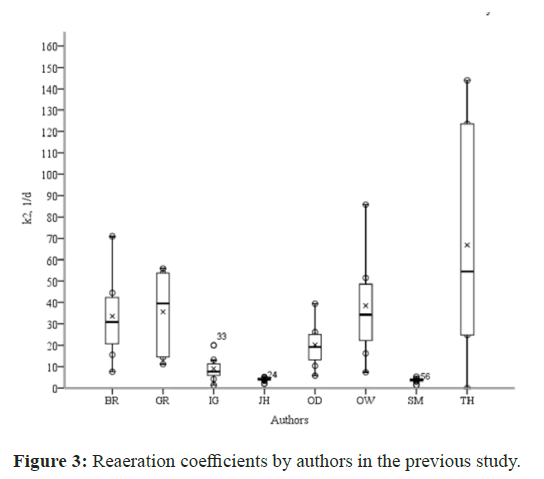
Figure 3: Reaeration coefficients by authors in the previous study.
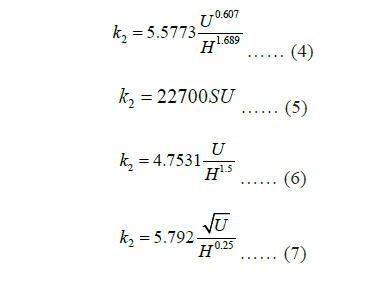

For the flow rate estimation of the Selbe River, the classic flow continuity formula was used at each sampling point by measuring the depth, width andvelocity (Table A1 in the Annex). The flow rate data at Selbe-Sanzai (very close to the primary source) and Selbe-Dambadarjaa (our third upstream-1) water stations, provided by the national agency for meteorology, hydrology and environmental monitoring, showed that from 2008 to 2019, the annual average flow rate of the Selbe River ranged from 0.11 m³/s in 2011 to 0.56 m³/s in 2019. The measured and estimated mean discharge of the Selbe River is 0.286 m³/s, which falls within this range (Table 1).
Analyzing the standard deviation in the Selbe River k2 values for each model, the lowest standard error of the mean was found in the Jha and Smoot models, with values of 0.38 and 0.52, respectively (Table A4 in the Annex). These results indicate that Jha et al., model is more reliable due to its smaller standard error of the mean [18]. Consequently, we used the mean reaeration rate k2 of 3.91, derived from Jha’s model, to determine the critical time and oxygen levels based on the actual temperature at all sampling points (Table A2 in the Annex). The mean k2 at 20ºC was found to be 5.13 1/d using Equation 14. The self-purification constant parameter, ��=29.4, is used to determine the rates of reaeration and deoxygenation in the Selbe River [29,30]. This parameter represents the ratio of k2 to k1, indicating that the river has streams with high energy and gradients. As temperatures increase, the processes of deoxygenation and reaeration are influenced by the river’s self-purification. The decomposition rates of organic matter accelerate faster than the reaeration rates, leading to an increased deoxygenation rate [4]. In the Selbe River, the reaeration rate k2 significantly exceeds the deoxygenation rate c1, enhancing its capacity for BOD assimilation (refer to Table 4) [31]. The ability of rivers and streams to assimilate BOD at various sampling points will vary depending on stream type. For simplicity, the following analysis considers the impact of pollution sources on the river with different downstream flow rates, geometry and temperature. The self-purification of the Selbe River was calculated using the Streeter-Phelps models (Equation 12, Equation 13 and Equation 14). Although these models were developed before the era of global warming, they can still represent the effects of dispersed pollution across all sampling points.
Table 4: The distances of sampling points at a critical oxygen deficit.

Where DOmin = Minimum dissolved oxygen concentration, mgO2/L; DOsat = Saturated dissolved oxygen concentration, mg O2/L; Di = Initial dissolved oxygen deficit, mg O2/L; k1 = Deoxygenation rate constant, 1/d; k2 = Reaeration rate constant, 1/d; tc=critical time, d, (travel time above zero); and UBOD=ultimate BOD, mg O2/L at mixing point.
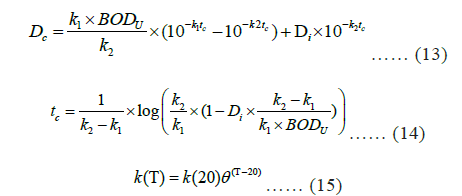
The initial oxygen deficit (����) is ignored due to the assumption of dispersed pollution at the sampling points. The result has been shown in Figure 1A which is depicted in each sampling point. However, the critical time (tc) and critical oxygen deficit (����=DOsat−DO) are not correlated to the next sampling point’s DO concentration. Therefore, we used Equation (12) and Equation (13) and found that the critical time at the upstream-1 and upstream-2 sampling points could not be determined due to negative or zero arguments in the logarithmic function. To validate the critical time values at the upstream1 and the upstream-2 they should be equal to or greater than zero when the BODU of these sampling points is higher than 23.1 mg/L and 19.95 mg/L, respectively, based on the logarithmic function condition. This result indicates that the Streeter-Phelps river purification model remains useful and reliable, even though it was developed before the current concerns regarding climate change.
According to the Mongolian National Standard (MNS:4943- 2015), the standardized BOD5 and COD should be less than 20 mg/L and 50 mg/L respectively. Typically, BOD5 is 68% of BODU, which means that BODU would be approximately 29 mg/L. This indicates that the BODU value at the upstream sampling point is comparatively lower than the ratio of BOD5 to BODU specified in MNS:4943-2015.
Dissolved oxygen saturation concentration (DOsat) is dependent on temperature, elevation above sea level and salinity of the sampling points, as formulated in equations [2,17]. The downstream-1 sampling point is highly polluted, characterized by a critical oxygen deficit (Dc), a critical oxygen distance of 6 km and a critical time of 8.8 hours at 20ºC. The critical distance between the downstream-1 and the downstream-2 exceeds the actual distance of 3.76 km. Additionally, the reaeration selfpurification distances at the sampling points did not extend beyond the confluence of Dund River with the Tuul River (Table 4 and Figure 4). These results indicate that the Selbe and Dund Rivers can be significant contamination sources for the Tuul River basin. However, the BOD assimilation capacity is higher at downstream-2 point, indicating purification processes are more effective at this point. The critical distance of the deoxygenation rate in a river refers to the distance over which the DO concentration decreases to a critical level that can harm aquatic organisms. This critical distance depends on several factors, including the sources of DO, BOD and nutrients in the water, temperature, flow rate and depth of the water column (Table 3).

Figure 4: Reaeration distances in sampling point (km).
Ulaanbaatar has experienced significant warming over the past 30 years. According to the Mongolian National Agency for Meteorology and Environmental Monitoring, the average temperature in Ulaanbaatar increased by about 2.24°C from 1990 to 2020 [20]. This warming trend is likely to have a significant impact on DO levels through pollution. The observed and predicted warming in the Selbe River is likely to have significant impacts on water quality, contributing to the contamination of the Tuul River basin. However, the DO concentration in the target river remains high despite low water quality.
This could be because the river is shallow, has high energy andhas a high gradient, allowing it to be well-replenished by atmospheric oxygen. The self -purification process of the Selbe River was analyzed at five sampling points using hydrological data, the deoxygenation rate constant k1 and the reaeration rate constant k2. Due to seasonal variations in the Selbe River during the study period, it was observed that the mean velocity is high relative to the river width at sampling locations such as “Upstream-1”, “Upstream-2” and “Middle point”, indicating effective self-purification of the Selbe River water at these points.
However, at the “Downstream-1” sampling point, it was found that the critical oxygen deficit, distance and critical time indicate that pollutants travel a distance of 5.9 km at 20ºC, with k2 calculated as 3.56 1/d (Table 4), based on Equation 14 of Arrhenius [21]. The National Meteorology Agency did not provide available data on BOD oxidation, which limited the estimation of the self-purification process of the Selbe River. Nevertheless, this study successfully achieved its primary objective of describing the deoxygenation rate constant k1 and reaeration rate constant k2 of the Selbe River.
The study examining the relationship between water quality parameters such as BOD5, BODU and DO, alongside river hydraulic characteristics including velocity, flowrate and depth in the Selbe River, Mongolia, highlighted that BODU plays a major role in determining the critical contamination distance in the river. Analysis using the Streeter-Phelps model across five sampling points (Figure 5) demonstrated that reaeration reaches satisfactory levels after approximately 1.6 days. Particularly downstream, adjacent to residential areas, there was a significant increase in BOD5 concentration, lengthening the deoxygenation process distance (Table 4). The water quality downstream remains significantly polluted, as indicated by the comparison of COD and BOD5 data against the Mongolia National Standard. However, the water is purified before it reaches the confluence with the Tuul River. This purification is achieved due to the shallow and higher gradient river of Selbe, which is supported by the measurements of DO at most sampling points.
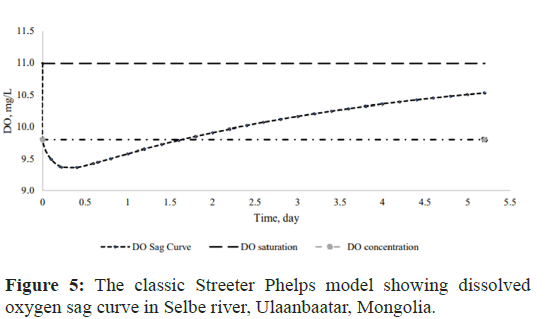
Figure 5: The classic Streeter Phelps model showing dissolved oxygen sag curve in Selbe river, Ulaanbaatar, Mongolia.
Efforts to address global warming in Ulaanbaatar should prioritize protective measures and public awareness campaigns. Future research should expand on these findings with continuous data collection throughout different seasons, including summer and autumn. Despite its limitations, this study presents the first empirically based model for natural stream water purification in Mongolia. Ongoing initiatives to reduce climate change in Ulaanbaatar, such as adopting cleaner energy sources and improving energy efficiency, face challenges including limited resources and political obstacles.
Conclusion
Finally, failing to meet the requirements for a natural flow and failing to address pollution will have a negative impact on the balance of the ecosystem and the services it provides. In addition, the decrease in surface water availability needed to maintain natural runoff poses potential challenges in the future, especially during dry periods in arid years. Achieving a balance between social and economic progress and environmental sustainability becomes increasingly difficult in such circumstances.
References
- Batbayar Z, Dolgorsuren G, Bron J, Dolgorsuren G, Chagnaa N, et al. (2012) Tuul river basin integrated water management plan. Plan Minist Environ Green Dev.
- Overview of the Water Resources System and Management in Mongolia (2020) Asian Development Bank.
- Davaa G (2015) Surface Water Regime and Resource of Mongolia. Admon Printing, Ulaanbaatar.
- Chapra SC, Camacho LA, McBride GB (2021) Impact of global warming on dissolved oxygen and bod assimilative capacity of the world’s rivers: Modeling analysis. Water 13(17).
- Du X, Shrestha NK, Wang J (2019) Assessing climate change impacts on stream temperature in the Athabasca River Basin using SWAT equilibrium temperature model and its potential impacts on stream ecosystem. Sci Total Environ 650:1872-81.
- Ficklin DL, Stewart IT, Maurer EP (2013) Effects of climate change on stream temperature, dissolved oxygen and sediment concentration in the Sierra Nevada in California. Water Resour Res49(5):2765-82.
- Rehana S, Mujumdar PP (2012) Climate change induced risk in water quality control problems. J Hydrology 444:63-77.
- Santy S, Mujumdar P, Bala G (2020) Potential impacts of climate and land use change on the water quality of Ganga river around the industrialized Kanpur region. Sci rep10(1):9107.
- Orr HG, Simpson GL, Clers S, Watts G, Hughes M, et al. (2015) Detecting changing river temperatures in England and Wales. Hydrol Process 29(5):752-66.
- Sumiya E, Dorjsuren B, Yan D, Dorligjav S, Wang H, et al. (2020) Changes in water surface area of the lake in the Steppe Region of Mongolia: A case study of Ugii Nuur lake, Central Mongolia. Water 12(5):1470.
- Bolorjargal G, Batsuren D, Oyunbaatar D, Erdenebayar B (2023) Impact of climate change and water regime in the Khovd River basin. Geograph Issues 23(01):37-49.
- Thomas Jr AH (1950) Graphical determination of BOD curve constants. Water Sewage Works 97:123-4.
- Sheehy JP (1960) Rapid methods for solving 1st-order equations. J water poll cont federan 32(6):646-52.
- Oke IA, Akindahunsi AA (2005) A statistical evaluation of methods of determining BOD rate. J Appl Sci Res 1(2):223-7.
- Jerry A, Nathanson, Schneider RA (2015) Water Pollution. Basic Environ Technol Water 6:106–128
- Thomann RV, Mueller JA. Principles of surface water quality modeling and control. Harper Row Publishers.
- Haider H, Ali W, Haydar S (2013) Evaluation of various relationships of reaeration rate coefficient for modeling dissolved oxygen in a river with extreme flow variations in Pakistan. Hydrol Processes 27(26):3949-63.
- Jha R, Ojha CS, Bhatia KK (2001) Refinement of predictive reaeration equations for a typical Indian river. Hydrol Processes 15(6):1047-60.
- Melching CS, Flores HE (1999) Reaeration equations derived from US Geological Survey database. J Environ Engin 125(5):407-14.
- Nadmitov B, Hong S, Kang S, Chu JM, Gomboev B, et al. (2015) Large-scale monitoring and assessment of metal contamination in surface water of the Selenga River Basin (2007–2009). Environ Sci Pollut Res Int 22:2856-67.
[Crossref] [Google Scholar][Pubmed]
- Oyunbat P, Munkh EA, Enkhbayar B, Batkhishig O, Myagmartseren P. Environmental impact assessment of pit latrines using remote sensing and multi-criteria spatial analysis in Ulaanbaatar (ger area), Mongolia. Int Arch Photogr Remote Sens Spati Info Sci 43:1279-85.
- Oyunbaatar D, Tsookhuu K (2001) Flow measurement in the Selbe river: A comparative analysis of hydrographic separation.
- Janjivdorj S (2012) Technical and economic feasibility study of restoration and improvement of Selbe river environment.
- Malsy M, aus der Beek T, Flörke M (2015) Evaluation of large-scale precipitation data sets for water resources modelling in Central Asia. Environ Earth Sci 73:787-99.
- National agency meteorology and the environmental monitoring (2019).
- MASM Aquatic environmental parameters, general requirement MNS 4586:1998 (2024).
- Standard methods for the examination of water and wastewater (2017).
- Determination of the deoxygenation rate of Selbe River and its purification study (2022).
- Fair GM (1939) The dissolved oxygen sag: An analysis. Sewage Works J 445:61.
- Ulseth AJ, Hall RO, Boix CM, Madinger HL, Niayifar A, et al. (2019)Distinct air–water gas exchange regimes in low and high-energy streams. Nature Geosci 12(4):259-63.
- Spark W (2023) Weather History in Ulaanbaatar Mongolia.
 Spanish
Spanish  Chinese
Chinese  Russian
Russian  German
German  French
French  Japanese
Japanese  Portuguese
Portuguese  Hindi
Hindi 